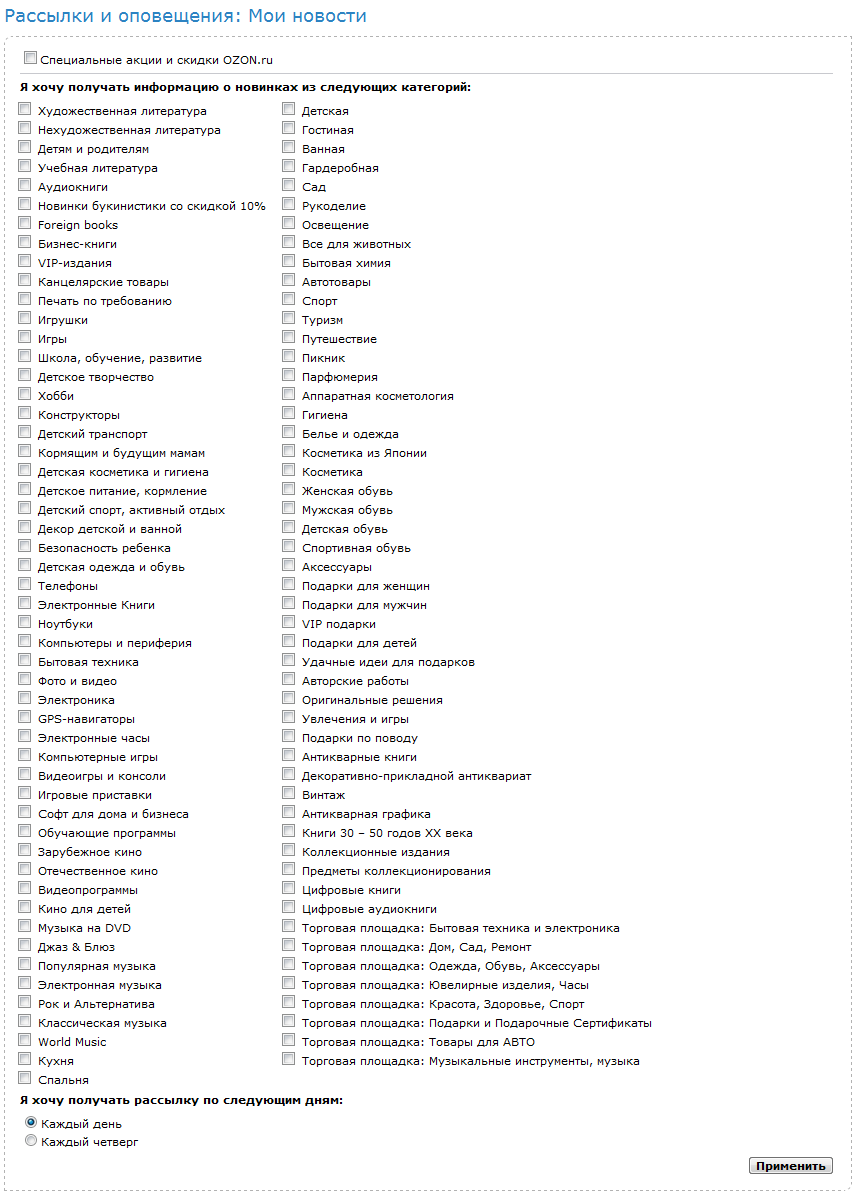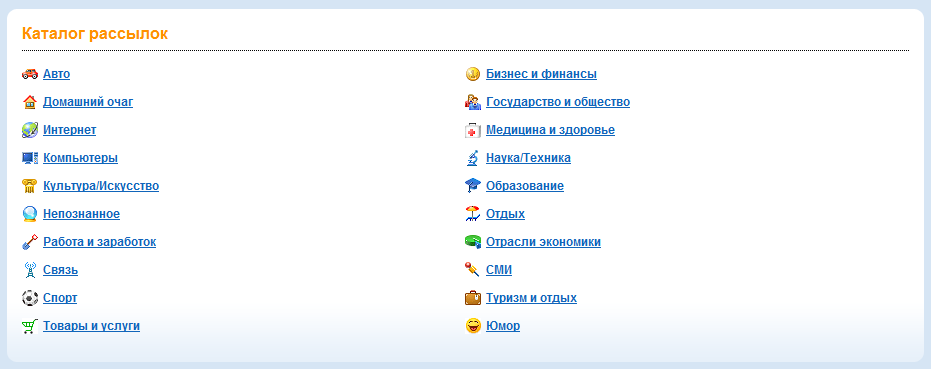Basics of email targeting and segmentation
If a client subscribes to our newsletter, this does not mean that it will exactly correspond to his interests. Alas, some companies do not take into account the fact that the needs and interests of their consumers can vary greatly. Suppose you sell sportswear and want to deliver information about updates to their customers. Ask yourself if a new line of women's sports suits will be interesting for a man? Does a teenager want to know more about baby products? Does a person who buys accessories to visit the gym need to buy a soccer ball at the same time?

Customer needs are as diverse as the range of your services. Most often, they need only a small fraction of the goods offered, and the expected mailing created without taking into account this simple truth becomes annoying spam. Even an excellent form and content letter will be without hesitation sent to the trash, if it does not contain information that interests the user.
')
Nobody requires to correspond with each of the clients personally: it is enough just to show respect to the interests of the subscriber. For this purpose, marketing methods of segmentation and targeting are used, that is, the division of the subscription audience into groups and individual work with each of them.
Segmentation is the process of dividing an audience into groups according to a certain attribute.
The list of addresses of your subscribers can be segmented into various groups: it all depends on the characteristics of the mailing list. The basics needed to divide an audience are usually collected directly during a subscription, but some (such as the frequency of clicking on links in a letter) continue to be updated constantly. Before you gather information, think carefully about what you need to know. Leave only the most necessary questions. Too detailed segmentation will throw you extra work. And besides, the fewer questions - the greater the chance that the user wishes to answer them.
When it comes to specifying personal information, the client is most often limited to an email address and name (or more often, a nickname if the questionnaire is filled out on the Internet). And no trust certificates will help to convince him to give more: even a big name and good reputation of the company will hardly cope with this task. How to get the necessary data?
To begin with, what should not be done:
Failure to follow these simple rules is a serious violation of the simplest standards of decency.
How to make the client show confidence in your mailings?
Show the client that you will send. Remember the suggestion to subscribe to the user's channel, shown at the end of some videos on YouTube? You need to get an idea from there: first a short, “catchy” material, then an offer to subscribe.
Show the user its benefits. Few people will just share their birth date. And if you indicate that on the birthday of the client special discounts or gifts are relied? A good newsletter is a mutually beneficial deal, do not forget to remind about it at any opportunity.
Questioning is only one of the ways to obtain information about the information required by the user. Unisender offers its customers segmentation based on tags assigned to contacts in the mailing list . Many services place care on the definition of the necessary types of letters on the user himself, offering to choose the subject of mailing, which he would like to receive. Pay attention to how Russian services did with the largest mailing campaigns.
OZON :

mail.ru :

There are various methods of splitting a list of addresses based on marketing strategies. The most popular of these is RFM segmentation, based on the ratio of the indicators of registration (or subscription) of the client and his activity (for example, the number of clicks on the link in the letter). The original also highlights the third feature - investments, - the amount of money spent by the client on services. But in the context of e-mail newsletters, this indicator is often excessive or equals to activity. I am going to devote a separate material to her, but for now those who wish can familiarize themselves with information on the topic from English-language resources.
Competent segmentation is the basis for effective letter personalization.

Personalization - an appeal to a specific client or on an individual occasion.
The fact that the letters sent to the user, it is better to contact him by name, already learned by many. Unisender offers this service for both email and sms-newsletters . But the possibilities of personalization are not limited to the treatment by name. As I wrote above, it can be both a birthday greeting and an individual offer due to its activity on the site.
Or automatic analysis of the interests of the user and appeal to him in accordance with his current needs. This will help you not only to satisfy the interests of the client, which he pointed out directly, but also to find workarounds for expanding the market without losing the trust of the audience. For example, if many customers purchasing item A also prefer item B, it may be worthwhile to offer all buyers of item A to pay attention to item B? Of course, there is some risk in such an approach: if many people receive letters irrelevant to their interests, this will reduce the chance that they will open the next letter. There should be a lot of precedents for buying two different goods together, the relationship between them should be obvious. And, nevertheless, even this will not give any guarantees that a person who has bought a coffee maker will want to learn about a new sort of custard coffee.
Segmentation allows you to understand who your customers are and is the main competent targeting.

Targeting - appeal to the part of the audience that is allocated according to a certain criterion.
This is obviously the next step after segmentation, and you should be ready not only to divide the list of subscribers, but also to specialize the letters sent to them.
Is it too difficult to start working with an audience divided into a large number of groups? Start simple! It is always possible to divide customers by at least two criteria: new / old and active / inactive. You want to make the best impression on new customers, while the old ones are already accustomed to the mailing list and can forgive a mistake or two: you do not need to surprise them, just do the same as always. You can tell about the activity of a client by how many times he opens a letter and whether he follows links in it. Perhaps it makes sense to make inactive customers a special offer in order to check the effectiveness of mailing in their attitude and try to return their interest? These are the basics of targeting. The beginning of "live" work with the client, communication instead of the usual "informing".
Abroad, where a subscription to sales letters is considered the most commonplace, the practice of segmentation has long been adopted. For Runet, where legal mailings are only in their infancy and are often associated exclusively with spam, the use of segmentation and targeting techniques can be a vital step: it is a way to show the subscriber that he will receive not just additional information noise, but valuable and profitable data, which can help in saving, and in acquiring the necessary things, and simply in accessing interesting content.
PS We will continue the in-depth story about the theory and practice of segmentation and targeting of mailings in the following posts. Subscribe to the Unisender company blog and you will see our posts in your habranth.

Customer needs are as diverse as the range of your services. Most often, they need only a small fraction of the goods offered, and the expected mailing created without taking into account this simple truth becomes annoying spam. Even an excellent form and content letter will be without hesitation sent to the trash, if it does not contain information that interests the user.
')
Segmentation
Nobody requires to correspond with each of the clients personally: it is enough just to show respect to the interests of the subscriber. For this purpose, marketing methods of segmentation and targeting are used, that is, the division of the subscription audience into groups and individual work with each of them.
Segmentation is the process of dividing an audience into groups according to a certain attribute.
The list of addresses of your subscribers can be segmented into various groups: it all depends on the characteristics of the mailing list. The basics needed to divide an audience are usually collected directly during a subscription, but some (such as the frequency of clicking on links in a letter) continue to be updated constantly. Before you gather information, think carefully about what you need to know. Leave only the most necessary questions. Too detailed segmentation will throw you extra work. And besides, the fewer questions - the greater the chance that the user wishes to answer them.
When it comes to specifying personal information, the client is most often limited to an email address and name (or more often, a nickname if the questionnaire is filled out on the Internet). And no trust certificates will help to convince him to give more: even a big name and good reputation of the company will hardly cope with this task. How to get the necessary data?
To begin with, what should not be done:
- Do not mislead the client! If you need an address for regular distribution, be sure to notify him about it.
- Do not force the client! If you specify the date of birth and marital status - the mandatory requirements for registering on the site, the user will indicate false data, or simply refrain from using such a resource.
Failure to follow these simple rules is a serious violation of the simplest standards of decency.
How to make the client show confidence in your mailings?
Show the client that you will send. Remember the suggestion to subscribe to the user's channel, shown at the end of some videos on YouTube? You need to get an idea from there: first a short, “catchy” material, then an offer to subscribe.
Show the user its benefits. Few people will just share their birth date. And if you indicate that on the birthday of the client special discounts or gifts are relied? A good newsletter is a mutually beneficial deal, do not forget to remind about it at any opportunity.
Segmentation methods
Questioning is only one of the ways to obtain information about the information required by the user. Unisender offers its customers segmentation based on tags assigned to contacts in the mailing list . Many services place care on the definition of the necessary types of letters on the user himself, offering to choose the subject of mailing, which he would like to receive. Pay attention to how Russian services did with the largest mailing campaigns.
OZON :

mail.ru :

There are various methods of splitting a list of addresses based on marketing strategies. The most popular of these is RFM segmentation, based on the ratio of the indicators of registration (or subscription) of the client and his activity (for example, the number of clicks on the link in the letter). The original also highlights the third feature - investments, - the amount of money spent by the client on services. But in the context of e-mail newsletters, this indicator is often excessive or equals to activity. I am going to devote a separate material to her, but for now those who wish can familiarize themselves with information on the topic from English-language resources.
Personalization
Competent segmentation is the basis for effective letter personalization.

Personalization - an appeal to a specific client or on an individual occasion.
The fact that the letters sent to the user, it is better to contact him by name, already learned by many. Unisender offers this service for both email and sms-newsletters . But the possibilities of personalization are not limited to the treatment by name. As I wrote above, it can be both a birthday greeting and an individual offer due to its activity on the site.
Or automatic analysis of the interests of the user and appeal to him in accordance with his current needs. This will help you not only to satisfy the interests of the client, which he pointed out directly, but also to find workarounds for expanding the market without losing the trust of the audience. For example, if many customers purchasing item A also prefer item B, it may be worthwhile to offer all buyers of item A to pay attention to item B? Of course, there is some risk in such an approach: if many people receive letters irrelevant to their interests, this will reduce the chance that they will open the next letter. There should be a lot of precedents for buying two different goods together, the relationship between them should be obvious. And, nevertheless, even this will not give any guarantees that a person who has bought a coffee maker will want to learn about a new sort of custard coffee.
Targeting
Segmentation allows you to understand who your customers are and is the main competent targeting.

Targeting - appeal to the part of the audience that is allocated according to a certain criterion.
This is obviously the next step after segmentation, and you should be ready not only to divide the list of subscribers, but also to specialize the letters sent to them.
Is it too difficult to start working with an audience divided into a large number of groups? Start simple! It is always possible to divide customers by at least two criteria: new / old and active / inactive. You want to make the best impression on new customers, while the old ones are already accustomed to the mailing list and can forgive a mistake or two: you do not need to surprise them, just do the same as always. You can tell about the activity of a client by how many times he opens a letter and whether he follows links in it. Perhaps it makes sense to make inactive customers a special offer in order to check the effectiveness of mailing in their attitude and try to return their interest? These are the basics of targeting. The beginning of "live" work with the client, communication instead of the usual "informing".
Theory and practice
Abroad, where a subscription to sales letters is considered the most commonplace, the practice of segmentation has long been adopted. For Runet, where legal mailings are only in their infancy and are often associated exclusively with spam, the use of segmentation and targeting techniques can be a vital step: it is a way to show the subscriber that he will receive not just additional information noise, but valuable and profitable data, which can help in saving, and in acquiring the necessary things, and simply in accessing interesting content.
PS We will continue the in-depth story about the theory and practice of segmentation and targeting of mailings in the following posts. Subscribe to the Unisender company blog and you will see our posts in your habranth.
Source: https://habr.com/ru/post/130829/
All Articles